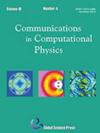Asymptotic-Preserving Neural Networks for Multiscale Kinetic Equations
IF 2.6
3区 物理与天体物理
Q1 PHYSICS, MATHEMATICAL
引用次数: 0
Abstract
In this paper, we present two novel Asymptotic-Preserving Neural Networks (APNNs) for tackling multiscale time-dependent kinetic problems, encompassing the linear transport equation and Bhatnagar-Gross-Krook (BGK) equation in all ranges of Knudsen number. Our primary objective is to devise accurate APNN approaches for resolving multiscale kinetic equations, which is also efficient in the small Knudsen number regime. The first APNN for linear transport equation is based on even-odd decomposition, which relaxes the stringent conservation prerequisites while concurrently introducing an auxiliary deep neural network. We conclude that enforcing the initial condition for the linear transport equation with inflow boundary conditions is crucial for this network. For the Boltzmann-BGK equation, the APNN incorporates the conservation of mass, momentum, and total energy into the APNN framework as well as exact boundary conditions. A notable finding of this study is that approximating the zeroth, first, and second moments—which govern the conservation of density, momentum, and energy for the Boltzmann-BGK equation, is simpler than the distribution itself. Another interesting phenomenon observed in the training process is that the convergence of density is swifter than that of momentum and energy. Finally, we investigate several benchmark problems to demonstrate the efficacy of our proposed APNN methods.用于多尺度动力学方程的渐近保全神经网络
在本文中,我们提出了两种新型渐近保全神经网络(APNN),用于解决多尺度时间相关动力学问题,包括克努森数所有范围内的线性传输方程和巴特纳加-格罗斯-克罗克(BGK)方程。我们的主要目标是为解决多尺度动力学方程设计精确的 APNN 方法,这种方法在小克努森数体系中也很有效。第一个用于线性输运方程的 APNN 基于偶数分解,它放宽了严格的守恒前提条件,同时引入了一个辅助深度神经网络。我们的结论是,强制执行具有流入边界条件的线性输运方程的初始条件对该网络至关重要。对于 Boltzmann-BGK 方程,APNN 将质量、动量和总能量守恒以及精确边界条件纳入 APNN 框架。本研究的一个显著发现是,对于波尔兹曼-BGK 方程来说,近似求得控制密度、动量和能量守恒的第零、第一和第二矩比求得分布本身更简单。在训练过程中观察到的另一个有趣现象是,密度的收敛比动量和能量的收敛更快。最后,我们研究了几个基准问题,以证明我们提出的 APNN 方法的有效性。
本文章由计算机程序翻译,如有差异,请以英文原文为准。
求助全文
约1分钟内获得全文
求助全文
来源期刊

Communications in Computational Physics
物理-物理:数学物理
CiteScore
4.70
自引率
5.40%
发文量
84
审稿时长
9 months
期刊介绍:
Communications in Computational Physics (CiCP) publishes original research and survey papers of high scientific value in computational modeling of physical problems. Results in multi-physics and multi-scale innovative computational methods and modeling in all physical sciences will be featured.
 求助内容:
求助内容: 应助结果提醒方式:
应助结果提醒方式:


